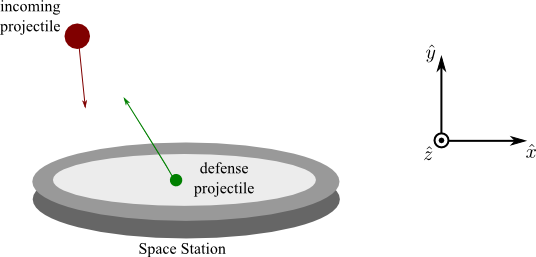This is an old revision of the document!
Project 11: Part A: Saving a space station
The satellite with HAL is on it's way back to Earth but behind the satellite is a number of small asteroids. A member of the recovery team, David Lightman, tells you that there is a defunct Earth defense floating space station that is very far from Earth which can be hacked into. You have been tasked with operating this projectile defense system (PDS for short). PDS has the ability to launch defense projectiles from the space station headquarters (positioned at the center of the space station) to divert incoming attack projectiles (asteroids heading for Earth). Before the first firing of a projectile from the defense system, your boss would like to see a simulation showing how the incoming attack projectile's motion can be changed by the defense projectile to be sure that you can be trusted with the PDS.
- The mass of a defense projectile is about $20\,{\rm kg}$, made out of sticky Space Clay™.
- The average mass of an attack projectile is about $5$ times that of a defense projectile, usually made of a solid metallic material.
Complete the code below to simulate before and after an interception (collision) for a worst case scenario: an attack projectile being launched directly towards headquarters at its largest ever recorded velocity $\langle 225,-400,0 \rangle\,{\rm m/s}$ from its closest ever recorded position $\langle -500,900,0 \rangle\,{\rm m}$. For this worst case scenario defense to be successful, you must push the incoming attack projectile back along its incoming path so that its velocity is $\langle -450,800,0 \rangle\,{\rm m/s}$. Your code should be general enough to handle other attack and defense projectile initial conditions.
Furthermore, the Department of Projectile Energy (DoPE) for the Thunderdome, your home base, would like a report on the loss of kinetic energy during the collision as it interested in further harnessing the power of the PDS once this asteroids problem is over. Use VPython's graphing capabilities to help answer how much energy is lost.
https://www.glowscript.org/#/user/paul.w.irving/folder/Public/program/SpaceStationCollision
